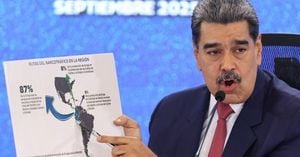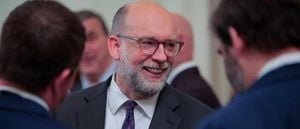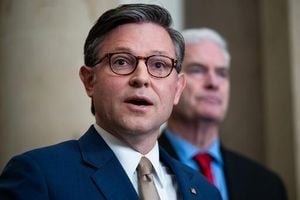Canada’s political and economic landscape is experiencing a seismic shift as Prime Minister Mark Carney’s new Liberal government unveils its first budget, a document shaped by the aftershocks of U.S. trade disruptions and the pressing need for national resilience. Presented on Tuesday, November 4, 2025, the budget arrives against the backdrop of an uneasy relationship with the United States, whose recent trade policies under President Donald Trump have rattled Canadian industries and left policymakers scrambling for new strategies.
“Our relationship with the United States will never be the same as it was,” Carney declared in a pre-budget speech at the University of Ottawa on October 1, 2025, setting the stage for a plan that he says is about “building, taking control, and winning.” According to Digital Journal, Carney has repeatedly emphasized the need for “bold risks” to reform an economy facing unprecedented threats from its southern neighbor. The numbers tell a stark story: U.S. tariffs have hit Canada’s auto, aluminum, and steel sectors hard, driving up unemployment and squeezing businesses that once thrived on cross-border commerce.
The budget’s headline items reflect this new reality. Carney’s government is proposing major increases in defense spending, aiming to bring Canada in line with NATO’s target of two percent of gross domestic product. As reported by The Canadian Press, Carney announced less than two months after his April election win that Canada would achieve the two percent target this year and further bolster military spending in the years to come. This marks a significant policy pivot, one that aligns with U.S. demands for greater burden-sharing among NATO allies and signals a new era of Canadian assertiveness on the world stage.
But the new budget is about more than just defense. Funds are being allocated to a suite of national projects that Carney has described as essential to Canada’s economic sovereignty. These include port expansion, energy production, and the infrastructure needed to extract critical minerals from remote regions—resources that are increasingly seen as vital for economic security in a world where old trade relationships can no longer be taken for granted. “We used to take big, bold risks in this country. It is time to swing for the fences again,” Carney told students in Ottawa, underscoring the government’s resolve to chart a new course.
Of course, such ambition comes with a hefty price tag. While Carney and Finance Minister Francois-Philippe Champagne have signaled that some of the increased spending will be offset by cuts to government operating budgets, those savings won’t cover all the new costs. University of Ottawa public policy expert Genevieve Tellier told AFP she expects the deficit to be “very large,” possibly around CAN$100 billion (about US$71 billion). That’s an eye-popping figure, but one that Carney’s government seems willing to accept in pursuit of economic independence and long-term stability.
Carney’s April 28, 2025, election win gave the Liberals a mandate, but not a majority—they’re three seats short in the House of Commons. This means the government needs opposition support or at least abstentions to pass the budget, a process fraught with political risk. The budget is a confidence vote, so its defeat would trigger fresh elections. “Anything is possible,” McGill University political scientist Daniel Beland told Digital Journal, noting that the Liberals will “try everything” to pass the budget. Polling suggests Carney’s popularity has softened since the election, leaving the government in a delicate position as it negotiates with rivals and seeks to avoid a snap vote.
Much of this turbulence can be traced to the ongoing friction with the United States. Trump’s trade policies have not only battered key Canadian industries but also upended the diplomatic playbook. Carney, a former central banker who only entered politics in January, was chosen in part for his international experience and his perceived ability to negotiate with Trump. Yet, as opposition parties have been quick to point out, he has so far failed to secure a new tariff-easing trade deal with the U.S. Trade talks stalled completely in October after an anti-tariff advertisement by Ontario’s provincial government—one that quoted former President Ronald Reagan—provoked Trump to suspend negotiations.
Internal government documents obtained by The Canadian Press reveal that Carney was carefully coached ahead of his first call with Trump after the election. The memo prepared for Carney suggested he push back if Trump raised familiar complaints about border security, fentanyl, or low defense spending. Carney was advised to remind Trump that both nations benefit from a strong and secure border, with “pressures going both ways,” and to stress that Canada “is not the source” of fentanyl in the U.S. The memo underscored Canada’s efforts to shut down even trace amounts of the opioid crossing the border and pointed to ongoing challenges with precursor chemicals from China and other countries.
On defense, Carney was told to agree with the need for NATO allies to increase spending and to highlight Canada’s commitment to accelerating its own timeline. The goal: to demonstrate that Canada is a “good faith partner” and to encourage the U.S. to return to the negotiating table. The leaders’ April 29 call, according to Canada’s official readout, was cordial—Trump congratulated Carney, and both agreed on the importance of working together as “independent, sovereign nations.” They even planned to meet in person before the June G7 summit in Kananaskis, Alberta, although the envisioned new economic and security partnership has yet to materialize.
Despite the high-profile setbacks, Carney has pointed out that roughly 85 percent of cross-border commerce remains tariff-free under the existing North American trade deal. That’s a crucial lifeline for Canadian businesses, even as the government scrambles to shore up vulnerable sectors and chart a new economic path. Public policy expert Genevieve Tellier told AFP that while the budget process is fraught with uncertainty, there’s “little chance” the government will fall over the vote. She predicts a flurry of last-minute negotiations before a decisive vote is called, and notes that there’s no clear indication that opposition parties would benefit from triggering new elections.
For ordinary Canadians, the stakes couldn’t be higher. The government’s willingness to run a record deficit, invest in national infrastructure, and boost defense spending reflects a belief that the country must adapt—or risk being left behind in a rapidly changing world. The old certainties of U.S.-Canada relations have faded, replaced by a landscape where bold action is not just desirable, but necessary. As Carney put it, “This is what this upcoming budget will be about: building, taking control, and winning.”
As Parliament prepares to debate the budget and the country waits to see whether Carney’s gamble pays off, one thing is clear: Canada’s future will be shaped not by nostalgia for the past, but by the risks its leaders are willing to take today.



